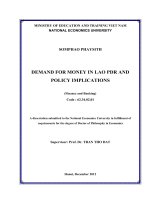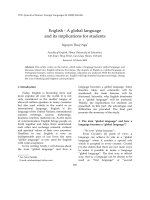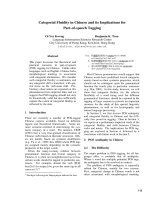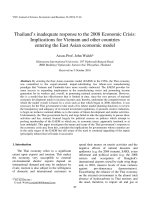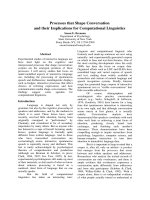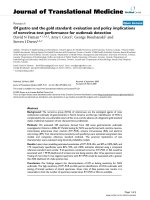Knowledge economy: Analytical framework and policy implications for Vietnam
Bạn đang xem bản rút gọn của tài liệu. Xem và tải ngay bản đầy đủ của tài liệu tại đây (534.36 KB, 14 trang )
20 | Nguyễn Trọng Hoài | 20 - 33
Knowledge Economy:
Analytical Framework and Policy Implications
for Vietnam
NGUYỄN TRỌNG HOÀI
University of Economics HCMC
Email:
ARTICLE INFO
Article history:
Received:
June 05, 2013
Received in revised form
July 11, 2013
Accepted:
Dec. 31, 2013
Keywords:
knowledge economy,
creative innovation, science
technology.
ABSTRACT
The paper presents an analytical framework and indicators measuring
progress of the knowledge economy according to the knowledge
assessment methodology introduced by the World Bank. Estimations
of Vietnam’s progress to the knowledge economy show that Vietnam
has made great efforts to build the knowledge economy, especially by
developing information and communication technologies. However,
the gap between Vietnam’s knowledge economy and other economies
in Asia as well as the world is still wide, especially in such pillars as
institutional regime, education, and development of innovation.
Vietnam, therefore, should adopt uniform policies on an overall and
profound reform in education and technology and in administrative
machinery to accelerate the development of knowledge economy.
Analytical Framework and Policy Implications
JED No.219 January 2014| 21
1. THE KNOWLEDGE CONOMY
In the knowledge economy, according to DTI (1998), creating and using knowledge
are crucial in the process of creating physical assets. This is not only an effort to surpass
existing knowledge, but also an efficient use of all kinds of knowledge in the economic
activities.
Powell & Snellman (2004) suppose that the knowledge economy is “based on
knowledge-intensive activities that contribute to an accelerated pace of technical and
scientific advance, as well as rapid obsolescence. The key component of a knowledge
economy is a greater reliance on intellectual capabilities than on physical inputs or
natural resources.”
Suh & Chen (2007) define a knowledge economy as “one that used knowledge as the
key engine of economic growth. It is an economy in which knowledge is acquired,
created, disseminated, and used effectively to enhance economic development.” Also
according to Suh & Chen, the concept of the knowledge economy “does not necessarily
revolve around high technology and information technology. For example, the
application of new techniques to subsistence farming can increase yield significantly, or
the use of modern logistical services can enable traditional craft sectors to serve broader
markets than before.”
Thus, the above definitions emphasize that knowledge is the key resource of a
knowledge economy compared to other tangible resources. It is as important as, or even
more than land and labor in agricultural economy or natural resources and machines in
industrial economy due to its non-stopped innovation and creativity in order to improve
labor productivity and contribute strongly to the economic growth and its quality.
2. WORLD PROGRESS TOWARD THE KNOWLEDGE ECONOMY
Many countries, especially developed ones, have made long and steady progress
toward the knowledge economy. According to the WB’s 2012 Knowledge Economy
Index (KEI), the world’s most advanced knowledge economies were Sweeden, Finland,
Denmark, Holland, Norway, Canada, Germany, Australia and Switzerland in that order.
Common features of these countries are a high-quality education, a modern
technological level and infrastructure, transparent and strict law system and great
support for innovation and creativity. In Asia, Taiwan held the highest rank (13 th),
followed by Japan (22nd), Singapore (23rd) and South Korea (29th). Particularly,
22 | Nguyễn Trọng Hoài | 20 - 33
development of knowledge economies in Japan and South Korea will provide Vietnam
with good lessons.
At present, Japan leads the way in economy, education, and technology. Japan has
invested massively in technology. In 2011 particularly, total budget for technology and
science is US$45.6 billion [1]. With the prime corporations in the world such as Sony,
Sumitomo, Mitsubishi, Toyota, etc., Japan is now a leader in the fields of electronics,
automobile, industrial robot, optics, chemicals, semiconductors and metals. Moreover,
an important contribution to Japan’s impressive growth comes from a strong
development of education system with many universities ranked among the world’s top
200 universities, among which Tokyo University and Kyoto University are the two
leading ones. The excellent education system helps Japan win 15 Nobel Prizes in
physics, chemistry, medicine, etc. and three Fields Medals in mathematics.
South Korea experienced rapid economic growth in the 1970s based on key industries
such as heavy, chemical and then electronics industries. It gained access to important
technologies through licensing and original equipment manufacturing contracts. South
Korea bases its R&D foundation on governmental research institutes for absorbing
imported technologies and then develops their own new technologies.
All industries have their own contribution to R&D activities, accounting for 80% of
R&D expenditure and equaling to 3% of the GDP (World Bank, 2007). This huge
investment helps South Korean corporations become the world’s leaders in many fields
such as electronic products (Samsung, LG), automobile (Hyundai), and heavy industry
(Doosan), strong enough to compete with the US and European leading corporations.
During the process of economic development, South Korea has made great investments
in education and especially in training skilled and high-quality human resources. Today,
Pohang University of Science and Technology and Seoul University in South Korea are
among top universities in the world.
3. THE ROLE OF KNOWLEDGE ECONOMY IN VIETNAM’S DEVELOPMENT IN THE
21ST CENTURY
After over 25 years of economic reform, Vietnam has obtained considerable
achievements in all fields, developing from a poor country into an economy with high
growth rates in the world. This extensive growth, however, is based on huge investments
in labor-intensive industries enjoying abundant natural resources. This growth model is
no longer effective in the globalized economy with technological advances that changed
Analytical Framework and Policy Implications
JED No.219 January 2014| 23
drastically human ways of production and consumption. Thus, development of the
knowledge economy is considered as a driving force for Vietnam’s economy in the 21 st
century.
In the Socioeconomic Development Strategy for 2011-2020, the VCP defines “The
stronger the knowledge economy develops, the more people and knowledge becomes
decisive factors of a country’s development.” In the Platform on National Construction
in the Transitional Period to Socialism at the 11th National Congress, it confirmed: “The
revolution of modern science and technology, the development of the knowledge
economy as well as the globalization and international integration, are opportunities for
Vietnam’s economic growth. Thus, development in the knowledge economy is defined
as one of basic ways to achieve successfully the process of development in the
transitional period to socialism until the middle of the 21st century.”
According to “Political Report of the 10th Central Executive Committee” at the 11th
VCP National Congress: “The development in the knowledge economy is based on
development of education, training, science and technology; building up scientist and
technological infrastructures, especially information, communications and automation
technologies; enhancing R&D ability in combination with developing high-quality
human resources. In addition, Vietnam needs to develop strongly industrial and
agricultural products, hi-tech and knowledge-based services with high added value;
make the best use of Vietnamese knowledge and exploit the human knowledge to the
fullest; and build up and carry out plans to develop the knowledge economy up to 2020.”
Thus, the knowledge economy is defined as a main key of Vietnam’s economic
development in the 21st century. But where is Vietnam among other countries in the
evolution toward the knowledge economy and what are the measures to promote the
knowledge economy in Vietnam? This paper tries to answer such questions.
4. ANALYSIS OF PROGRESS TOWARD A KNOWLEDGE ECONOMY
The knowledge economy is considered as an essential driving force for economic
growth in the future. According to World Bank (2007), therefore, it could be built on
four pillars: (1) Economic and institutional regime; (2) Education; (3) Innovation
system; and (4) Information and communication infrastructure.
Economic and institutional regime: include economic policies and institutions that
mobilize and allocate labor, encourage entrepreneurship and stimulate creativity,
dissemination and use of knowledge. This pillar covers many policies such as macro
24 | Nguyễn Trọng Hoài | 20 - 33
economy, banking and finance, commerce, labor market, administration, etc. The
weakness in an economic and institutional regime can make business environment weak,
obscure, corrupt, and lack of motivation and opportunities for creativity. Thus, it will be
the largest obstacle to economic and social development generally and a knowledge
economy particularly.
Education: a well-educated and skilled labor force is needed for creativity and
effective use of knowledge. A system of education and training includes primary
schools, secondary schools, vocational school, tertiary education, and lifelong learning.
Lifelong learning plays an increasingly important role in the present knowledge
revolution. When new knowledge is continuously created, people are required to
improve skills at the speed of human knowledge development. Lifelong learning is the
only way to help workers develop their skills, catch up with the world’s advanced
technology, as well as help developing countries catch up with developed countries for
competitiveness.
Innovation system includes firms, research centers, universities and other
organizations that approach and keep up with new knowledge and technology to adapt
and use it for local needs. Additionally, support for technological and scientific
innovations also involves several factors from infrastructure to regime and from
dissemination of basic technology to advanced research activities. In developing
countries, most knowledge and techniques of innovation system are gathered from
foreign sources as FDI sectors, machines and equipment imported from developed
countries and licensing agreements.
Information and communication infrastructure: a modern and adequate information
infrastructure is a good condition for effective communication, processing and
dissemination of information. Information and communication technologies (ICTs),
including telecommunications, broadcast media, radio and internet are essential
infrastructures of the information-based global economy in the 21st century, and it is as
important as networks of railways, roads and water and power supplies in the 20 th
century. These infrastructures may reduce transactions costs by providing access to
information anytime and anywhere. Information and technology policies include
regulations on telecommunications and important investments to create and exploit
information and broadcast technologies through such e-applications as e-government, ebusiness, and e-learning, etc.
JED No.219 January 2014| 25
Analytical Framework and Policy Implications
The relationship between four pillars is presented in Figure 1. Economic and
institutional regime plays the role of a foundation for development of the other three
pillars. Only if an economic and institutional regime that encourages, nurtures and
supports development of new knowledge, innovation and creativity can the knowledge
economy have a good opportunity to develop.
EDUCATION
Training educated and skilled
workers who can use knowledge
effectively
INNOVATION SYSTEM
A system of organizations is
necessary to tap into the global
knowledge, assimilate and adapt it,
and create new knowledge for local
needs.
INFORMATION
INFRASTRUCTURE
Providing conditions for the
effective communication, processing
and dissemination of information.
ECONOMIC AND INSTITUTIONAL REGIME
Providing a driving force for creativity, dissemination and use of knowledge
Figure 1: Analytical Framework of Knowledge Economy Pillars
Source: World Bank (2007)
Moreover, there are close interactive relationships between these pillars. For
example, a society must achieve certain level of development in education to obtain
certain level of human capital before developing an effective system of research and
creativity or improving labor productivity due to investments in modern information and
technology infrastructure. Similarly, it is difficult for the innovation system to benefit
from the global knowledge if information and communication infrastructure is not
26 | Nguyễn Trọng Hoài | 20 - 33
sufficient. Thus, it is necessary to make balanced investments in four pillars for the
development of knowledge economy and additionally, combine all of them to improve
achieved results.
5. MEASUREMENT OF PROGRESS TOWARD KNOWLEDGE ECONOMY
Long-term strategies are required to develop a knowledge economy and promote its
four pillars, so it is necessary to establish variables for measuring strengths and
weaknesses of each pillar thereby helping policy makers select right policies. In addition,
variables for measuring progress by each country in every pillar are also needed. In order
to achieve this aim, World Bank Knowledge for Development Program developed an
interactive benchmarking tool to measure performance of each country on the four
knowledge economy pillars, called Knowledge Assessment Methodology (KAM)
(World Bank, 2012). This is an internet-based tool that can measure level of preparation
of each country for a knowledge economy. Additionally, it helps countries evaluate their
strengths and weaknesses based on the four knowledge economy pillars by comparing
themselves with others countries. According to World Bank Institute, KAM allows the
policy makers to identify the problems and opportunities their countries may face in
making a transition to the knowledge economy. At present, KAM is applied to measure
146 countries.
- KAM’s indexes
KAM also develops indexes besides 148 variables to reflect a country’s overall
progress toward the knowledge economy generally and in each group of variables
particularly. In addition to Knowledge Economy Index (KEI) [3] and Knowledge Index
(KI), the two most important overall indexes, there are indexes for the pillars of a
knowledge economy, including Economic and Institutional Regime Index, Education
Index, Innovation Index and ITC Index. Each index is calculated by a mean value of
three variables in each pillar that are presented in Figure 2, in which we can see that KEI
is calculated by 12 key variables of the four pillars.
JED No.219 January 2014| 27
Analytical Framework and Policy Implications
Knowledge Economy Index
Knowledge Index
(KI)
(KEI)
Economic and
Institutional Regime
Index
- Tariff & nontariff barriers
- Regulatory
quality
- Rule of law
Education
Index
- Average years of
schooling
- Secondary
enrollment
- Tertiary enrollment
Innovation
Index
- Royalty and license
fees payments and
receipts
- Patent applications
granted by the US Patent
and Trademark Office
- Scientific and technical
journal articles
ICT Index
- Telephones per
1,000 people
- Computers per
1,000 people
- Internet users per
10,000 people
Figure 2: Knowledge Indexes
Source: World Bank (2012b)
- Normalization of data
In 2012, KAM includes 148 [2] variables to measure countries’ performance on the
four KI pillars, economic situation and labor force. All variables are normalized on scale
of 0 to 10 and their normalization procedure is as follow:
- The actual data (u) is collected from datasets of World Bank or other resources for
148 variables and 146 countries.
- Ranks are allocated to countries based on the absolute values of each variable.
Countries with the same absolute values are allocated the same rank. Thus, a country in
the 1st place performs the best among the countries on a particular variable, a country in
the 2nd place performs second best, and so on.
- The number of countries with lower rank (Nw) is calculated for each country.
28 | Nguyễn Trọng Hoài | 20 - 33
- The following formula is used to normalize the scores for each country on every
variable, based on country’s rank and the number of countries in the sample (Nc) with
available data:
- The above formula allocates a normalized score from 0 (the worst) to 10 (the best)
for 146 countries on every variable among 148 ones. The top 10% of countries
performing the best receive a normalized score between 9 and 10, the second best 10%
of countries gets normalized scores between 8 and 9 and so on (World Bank, 2007).
6. VIETNAM’S PROGRESS TOWARD KNOWLEDGE ECONOMY
Vietnam has made some modest progress toward the knowledge economy. It
advanced nine steps from the 113th in 2000 to 104th position in 2012 with KEI of 3.4. Its
rank, however, was much lower than Singapore, Malaysia, Thailand and the Philippines,
ranked respectively 23rd, 48th, 66th and 92nd among 146 countries, and its normalized
score was lower than the Asia- Pacific average of 5.32.
Table 1 shows Vietnam’s performance on the four KI pillars in making the transition
to the knowledge economy over time. In the period 1995-2012, its ICT pillar was
improved while the others did not change much. Particularly, Vietnam rose 38 positions
to 75th place between 2000 and 2012 with a normalized score of 5.05 because of its
strongest performance in the ICT pillar. This was the only pillar that received a
normalized score up to 5, and it was also considered the best performance among four
pillars. Meanwhile, its EIR pillar and Education pillar did not change much , ranking
108th (normalized score of 2.8) and 105th (normalized score of 2.99) respectively in 2012.
Vietnam’s Innovation pillar is the weakest among the four KI pillars, rising from 117 th
place (normalized score of 2.4) in 2000 to 113th place (normalized score of 2.75) in 2012.
Table 1: Vietnam’s Advances in Four Pillars
2012
2000
1995
Economic and Institutional Regime Index
2.8
2.74
2.64
Education Index
2.99
2.82
2.28
Innovation Index
2.75
2.4
2.34
ICT Index
5.05
2.92
4.5
Source: World Bank (2012a)
JED No.219 January 2014| 29
Analytical Framework and Policy Implications
Table 2 analyzes in detail 12 variables for Vietnam’s four KI pillars over years.
Economic and institutional regime: generally, Vietnam made no progress in this pillar
where tariff and nontariff barriers received the lowest normalized score of 1.82 among
its three variables. This did not imply that Vietnam’s position was fallen compared to
2000, but compared to other advanced countries, Vietnam’s normalized score was
relatively lower. Its regulatory quality made a relative advance, rising from 1.79 points
in 2000 to 2.26 in 2012, which reflected its advances in public administration reform,
law improvement and transparency in finance and banking sector. In addition, its
variable for rule of law received the highest normalized score of 4.32 in 2012 compared
with other two variables, but no significant change compared to 2000 (normalized of
4.34) took place.
Education: all three variables for this pillar improved in absolute values. Specifically,
average years of schooling rose from 5.11 scores in 2000 to 6.43 scores in 2012; tertiary
enrollment rose from 9.6% in 2000 to 15.94% in 2012. However, such variables were
still lower than other countries in the world because they have not reflected the quality
of education, a key factor of Vietnam’s knowledge economy development.
Table 2: Variables for Four Pillars of Vietnam’s Knowledge Economy
2012
2000
1995
Tariff and nontariff barriers
1.82
2.07
1.86
Regulatory quality
2.26
1.79
2.87
Rule of law
4.32
4.34
3.19
S&T journal articles/ million people
2.62
1.92
1.52
Patents granted by USPTO/ million
people
2.88
2.88
3.17
Average years of schooling
2.2
1.89
1.89
Secondary enrollment rate
3.52
3.52
3.13
Tertiary enrollment rate
3.26
3.03
1.82
Total telephones per 1,000 people
6.21
2.48
2.55
Royalty payments and receipts
(US$/population)
30 | Nguyễn Trọng Hoài | 20 - 33
Computers per 1,000 people
4.52
3.45
3.49
Internet users per 1,000 people
4.41
2.83
7.45
Source: World Bank (2012a)
Innovation system: these variables ranked the lowest among Vietnam’s four KI
pillars. Particularly, science and technical journal articles per million people increased
from 1.92 in 2000 to 2.62 in 2012 which were lower than Thailand (normalized score of
25.79 articles) and Malaysia (30.43). Vietnam’s normalized score for patents granted by
USPTO (per million people) was 0.01 that was lower than Thailand (normalized score
of 0.51) and Malaysia (normalized score of 5.63). Such numerals have reflected a
restriction in research and creation capacity of Vietnam’s economy – an important
promotion for making the transition to the knowledge economy.
Information and communication technology was the Vietnam’s most advanced pillar.
Considered as one of the countries making the fastest development in information and
communication technology in the world, Vietnam made impressive improvement in this
pillar. Its total telephones and computers per 1,000 people rose more than 30 times from
40 to 1,360 and tenfold from 10 to 100, respectively between 2000 and 2012, and its
number of internet users per 1,000 people were 270 people (per 1,000 people) in 2012.
There is a correlation between advances in the knowledge economy of Vietnam and
other countries when we make a comparison between economies of Vietnam and of
Thailand, Malaysia, and Indonesia.
It is easy to see that the gap between Vietnam and Malaysia as well as Thailand is
rather large in all variables except information technology and communication
indicators. For example, total telephones per thousand people of Vietnam received a
normalized score of 6.21 compared to those of Malaysia and Thailand with 5.93 and
6.14 respectively. Its normalized score (4.41) for Internet users per 1,000 people was
higher than Thailand (4.28) but lower than Malaysia (7.59). Compared to Indonesia,
Vietnam has made a stronger performance in information and communication indicators
and a similar performance in the others.
JED No.219 January 2014| 31
Analytical Framework and Policy Implications
Table 3: Progress toward the Knowledge Economy of Vietnam, Thailand,
Malaysia and Indonesia
VN
Indonesia
Thailand
Malaysia
Tariff and nontariff barriers
1.82
3.36
3.99
4.62
Regulatory quality
2.26
3.56
5.96
5.68
Rule of law
4.32
3.49
5.41
6.71
5.12
6.8
7.28
Royalty payments and receipts
(US$/population)
S&T journal
people
articles/
million
2.62
0.83
5.17
5.45
Patents granted by USPTO/ million
people
2.88
3.77
5.89
8.01
Average years of schooling
2.2
2.05
3.15
7.32
Secondary enrollment rate
3.52
3.72
3.45
3.1
Tertiary enrollment rate
3.26
3.83
6.1
5.25
Total telephones per 1,000 people
6.21
3.38
6.14
5.93
Computers per 1,000 people
4.52
1.64
6.23
6.3
Internet users per 1,000 people
4.41
2.55
4.28
7.59
Source: World Bank (2012a)
In short, Vietnam has made great efforts to advance toward the knowledge economy,
especially in ICT. However, the gap in the knowledge economic growth between
Vietnam and other countries in the world is large. Thus, it should try to improve the
situation in the future, especially in its institutional regime, the quality of education and
innovation system.
7. POLICY IMPLICATIONS
Estimates of Vietnam’s progress toward the knowledge economy allow suggestion of
the following policy implications to improve the knowledge economy in Vietnam:
Firstly, Vietnam should improve its market economy and legal framework according
to international practices and WTO’s regulations to create a fair and transparent business
32 | Nguyễn Trọng Hoài | 20 - 33
environment, protect intellectual property and encourage entrepreneurship, promoting
innovation and creation in all sectors.
Secondly, it is necessary to carry out an overall reform in education and training of all
levels, especially the tertiary education. Additionally, development of the higher education
in Vietnam should be based on international standards in management, training, evaluation
and scientific research. Moreover, it should strive to strengthen several universities that
can be included in the top 200-500 ones in the world, and create the best conditions for the
major universities to train high-quality human resources to work in the knowledge
economy. Vietnam should also adopt policies to persuade excellent professors or experts
from abroad to join in teaching and research in Vietnam.
Thirdly, introduce long-term strategies for the techno-scientific development.
Particularly, it is essential to link research with application and development of a market
for scientific and technological researches. Other measures include absorbing effectively
foreign advanced technologies through cooperation, trade and technology transfer;
encouraging scientific researches and technology replacement in all sectors; building
armies of techno-scientific experts and research institutes of international standards; and
focusing on key industries of the knowledge economy such as information technology,
automation technology, biotechnology, and new materials and energy technology.
Finally, information and communication infrastructure and IT applications need to be
further developed. Incentives could be given to IT applications in all fields, especially
administration and e-government. Developing well-skilled IT human resources to meet
requirements by the knowledge economy is an urgent task that requires strategies to
develop IT and software engineering into a key industry and enhance export value of IT
products as the principal measure to improve Vietnam’s competitiveness in the 21 st
century
Note:
[1]
/>[2]
Details
of
the
indicators
/>
are
available
at
Analytical Framework and Policy Implications
JED No.219 January 2014| 33
[3] The KEI index is the most general index, calculated for each country. It is an aggregate index
representing a country’s overall development in the knowledge economy. The KEI index reflects a
country’s performance in the four KI pillars and is their average value.
References
VCP (2011), Báo cáo chính trị của Ban Chấp hành Trung ương Đảng khoá X (Political Report of the
10th Central Executive Committee) presented at the 11th VCP National Congress.
VCP (2011), Chiến lược phát triển kinh tế - xã hội 2011 – 2020 (Socioeconomic development strategy
for 2011 – 2020) presented at the 11th VCP National Congress
VCP (2011), Cương lĩnh xây dựng đất nước trong thời kì quá độ lên chủ nghĩa xã hội (Platform for
national construction in the transitional period to socialism) presented at the 11 th VCP National
Congress
DTI (UK Department of Trade and Industry) (1998), Building the Knowledge Driven Economy,
London DTI, />Powell, W. W. & K. Snellman (2004), “The Knowledge Economy”, Annual Review of Sociology,
30(1), pp. 199-220.
Suh, J., & D. H. C. Chen (2007), Korea as a Knowledge Economy: Evolutionary Process and Lessons
Learned, World Bank Institute Development Studies.
World Bank (2007), Building Knowledge Economies: Advanced Strategies for Development, World
Bank Institute Development Studies.
World Bank (2012a), Knowledge Assessment
/>
Methodology
2012,
World Bank (2012b), Knowledge Economy Index (KEI) 2012 Rankings,
World Bank. />
World
Bank,
